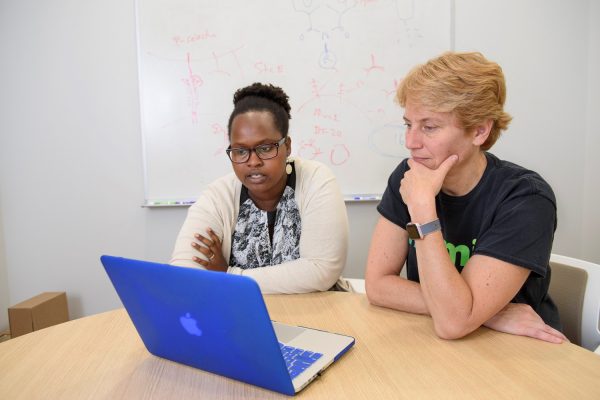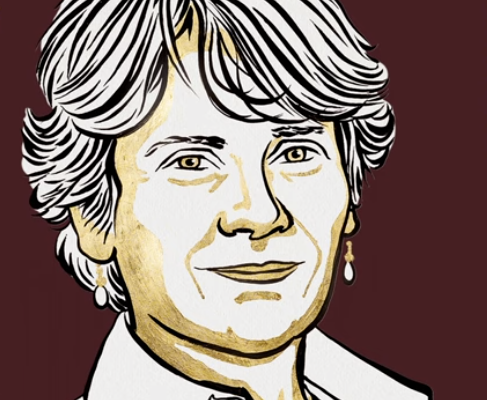Bertozzi Awarded Nobel Prize

Sweet Path to Success: How the Science of Sugars Scored a Nobel Prize in
Chemistry for Lexington Native
By Jane Whitehead
Rockstars rarely reach out to congratulate research scientists. But when Lexington native and Lexington High School 1984 graduate Carolyn R. Bertozzi was announced as one of three winners of the 2022 Nobel Prize for Chemistry, on October 5, among the cascade of well-wishes on social media was a tweet from ace guitarist Tom Morello, co-founder of the band Rage Against the Machine.Applauding his former Harvard bandmate, Morello recalled that their college band, Bored of Education, won the Ivy League Battle of the Bands in 1986, “with her on keyboards and me in spandex.” Far from being bored of education, after graduating from Harvard College in 1988 Bertozzi, now 56, chose grad school at UC Berkeley over the lure of musical fame and embarked on a stellar career as a researcher, teacher, and mentor. She is currently the Anne T. and Robert M. Bass Professor in the School of Humanities and Sciences, and a professor of chemistry at Stanford University.
Taking Chemistry Out of the Lab and into the Body
Bertozzi shares the 10 million Swedish kronor (around USD 900,000) prize with Morten Meldal, professor at the University of Copenhagen, and K. Barry Sharpless, professor at Scripps Research “for the development of click chemistry and bioorthogonal chemistry,” according to the press release from the Royal Swedish Academy of Sciences. Sharpless and Meldal are honored for developing “click chemistry,” a technique that enables scientists to snap molecular building blocks together quickly and efficiently and is widely used in developing pharmaceuticals and mapping DNA.
Bertozzi is recognized for developing click reactions that work inside living organisms without interfering with natural biological processes, through her invention of what she named “bioorthogonal chemistry.” As Bertozzi explained in a Stanford Tiny Lecture posted on the school’s Twitter feed on October 27, “it’s a chemistry that allows two molecules to come together and form a bond even when they’re surrounded by all the stuff that you would find in human cells and even in the human body.” As a result, she said, “we can do all kinds of interesting things that are of benefit for human health. We can make new medicines, we can target medicines to the right tissues, and we can see biological molecules in living organisms for the first time.”
Bertozzi developed bioorthogonal chemistry during decades-long investigations into the chemistry and biology of sugars. In a short lecture for Stanford’s 2019 Reunion Homecoming, “Stripping the Sugar Coating off Cancer,” she gave a user-friendly introduction to her lab’s research in the emerging field of glycoimmunology. “All our cells are coated in sugars, including cancer cells,” she said, and these long chains of complex carbohydrates anchored on the surface of our cells turn out to play a crucial role in the context of cancer.
It’s been known for decades that cancer cells often show a large, unruly growth of a sugar called sialic acid, Bertozzi explained. She and her team discovered that this sugary cloak tricks the body’s immune system into identifying these cells as healthy and leaving them alone. “It’s a bit like a Jedi mind trick made out of sugar,” she said. One outcome of this research is the development of medicines that act “like a molecular lawn mower” to remove the sialic acid, making cancer cells once again vulnerable to the immune system.
Phase 1 clinical trials of these drugs with a small number of advanced-stage cancer patients are underway at Palleon Pharmaceuticals, a Waltham-based biotech company founded in 2015 by CEO Dr. Jim Broderick to explore the therapeutic potential of glycobiology. Broderick launched an international search for leading experts in the field and invited Bertozzi to join Palleon as a scientific co-founder in April 2016, along with Paul Crocker, Professor of Glycoimmunology at the University of Dundee, Scotland.
“I’ve worked with a lot of world-class scientists,” said Broderick in a zoom call, “but Carolyn is probably the best I’ve ever worked with – she’s super-smart, but also very collaborative, very responsive.”
Phase 2 studies on patients with specific tumor types will start early in 2023, using technology developed by Palleon’s Chief Scientific Officer Li Peng, based on Bertozzi’s research. “I was deeply intrigued by the science,” said Li Peng, a biochemist, and molecular biologist. “I knew there were a lot of risks,” she said, but she saw such promise in the novel approach that she persuaded her husband and son to move from Maryland to Lexington in 2016, so she could join Palleon’s leadership team.
Palleon is one of eight medical-related start-ups founded or co-founded by Bertozzi since the early 2000s. Among the technologies they have developed are at-home diagnostics for type 1 diabetes, more efficient HIV and ovarian cancer tests, and lower-cost tests for tuberculosis. In a phone interview for the Nobel Committee immediately after Bertozzi learned of her award, Adam Smith asked what drives her prolific inventiveness. Beyond her sheer love of organic chemistry and biology, Bertozzi said that like many people, she has seen friends and family members suffer from untreatable illnesses. “It was always my hope that as a scientist I could make some contributions that would benefit human health, either in the near term or the long term, not even necessarily in my lifetime,” she said.
At Home with Science
The first person Bertozzi called on hearing of the Nobel was her father William Bertozzi, a retired MIT physics professor. “He’s 91 and of course, he was just overjoyed,” Bertozzi told the Stanford news team that set up camp in her Palo Alto house on the day the prize was announced. Having an experimental physicist for a father – and an education-minded mother, a former secretary in the MIT Physics Department who later earned a Bachelor’s degree from Wellesley College – set a high bar for the three Bertozzi girls, of whom Carolyn was the middle child. Norma G. Bertozzi passed away in Lexington in October 2021 and sadly did not live to see her daughter’s crowning achievement.
Their Lexington home overflowed with gadgets and DIY projects, and William Bertozzi enlisted his daughters to help with everything from home improvements to lawn-mower repair. They also had a computer terminal, hooked up by phone to an MIT mainframe, on which they learned the basics of programming and played some of the earliest computer games, Bertozzi told an interviewer for a Science History Institute (SHI) oral history project in 2003.
“The story of my life was trying to keep up with my older sister,” Bertozzi told the interviewer. Her older sister Andrea was a math prodigy who, as a middle-schooler had to be shipped off to LHS for math classes. She is an award-winning applied mathematician and Distinguished Professor of Mathematics and Mechanical and Aerospace Engineering at UCLA. When Andrea Bertozzi was elected to the National Academy of Sciences (NAS) in 2018, she and Carolyn, who had been a member since 2005, became the first sister pair in the NAS. Their younger sister Diana Bertozzi Hindermann chose a less single-mindedly academic path, and practices as an occupational therapist in New Jersey.
At LHS Bertozzi was “kind of a jock,” she told the SHI oral history interviewer. “It’s not like I was a dumb jock; I was a pretty hard-working jock, but I wasn’t a genius and I had to work hard to do well,” she said. She also played piano and keyboards and flirted with the idea of music as a career, against the family ethos of education as the highway to employability and security.
Retired LHS music maestro Jeff Leonard taught Bertozzi in his jazz improv class. “You could tell she was just passionate about what she was learning,” he said in a recent phone call. He recalled her “intense level of engagement,” and her occasional impatience with classmates who were goofing off. “She wanted to be on task,” he said, and she brought “heart, soul, and mind” to her music. If she had chosen music as a career, he said, he thinks she would have succeeded, thanks to her drive and focus. “But I think she’s probably done the world a greater service, doing what she did,” he added.
The Nobel Prize is only the most recent and prestigious of Bertozzi’s array of honors. At age 33 she was one of the youngest ever recipients of a MacArthur Fellowship, and in 2010 won the Lemelson-MIT Prize, the largest cash prize for invention in the US In June 2022, she was one of a trio of scientists to be awarded the Wolf Prize in Chemistry, an international award “for achievements in the interest of mankind and friendly relations amongst peoples.” On November 17, in a virtual ceremony, she will receive the Wistar Institute’s Helen Dean King Award for “outstanding women in biomedical research.”
Shaping the Future Face of Science
As an openly gay female leader in the still-male-dominated fields of chemistry and chemical biology, Bertozzi is seen as a champion of diversity and a prolific mentor to younger scientists. The American Association for the Advancement of Science (AAAS) has honored her with its 2022 Lifetime Mentor Award, noting that in a 25-year career, including 20 years at UC Berkeley, before her 2015 move to Stanford, Bertozzi has mentored over 270 postdocs, graduate students, and undergraduate researchers, including 52 women and students from underrepresented minorities.
“I consider it a great privilege to be in a position to mentor brilliant and motivated young scientists, help launch their careers, and contribute to diversification of the scientific workforce,” Bertozzi told AAAS.

Burundian-born American bioscientist Mireille Kamariza was a graduate student in Bertozzi’s lab from 2013 to 2019. When she heard the news about her mentor’s Nobel, Kamariza’s first thought was, it’s about time! “My second thought was, they couldn’t have picked a better person,” said Kamariza, who is currently a Junior Fellow at Harvard’s prestigious Society of Fellows and will move to UCLA in January 2023 as Assistant Professor of Bioengineering
“Carolyn fervently believes in her people,” said Kamariza. “She has this uncanny ability to see what people want to do and then give them the resources to flourish.” What Kamariza wanted to do was develop a rapid low-cost TB test for use in low-income countries like her native Burundi, where the disease is one of the top ten causes of death. With Bertozzi’s support, she not only invented a new point-of-care diagnostic device for TB but also co-founded a company, OliLux Biosciences, to bring it to market with the aid of a Gates Foundation grant.
“I’m not the person you imagine when you think of the CEO of a company!” said Kamariza, a young, Black woman who fled civil war and came to the US at age 17 as a refugee who spoke no English. But through many hours of strategizing, Bertozzi convinced her that she was exactly the right person to take on this role.
For Kamariza, there was an added sweetness to the announcement of Bertozzi’s Nobel. “Just for the work alone, Carolyn absolutely deserves it,” she said. But what really made her proud and thrilled, she said, were “the testimonies that came pouring out that day, from all the students and collaborators and people she’s interacted with, talking about how she’s improved their lives in so many ways. That in itself is worth the Nobel, I think!”


LEXINGTON’S NOBEL CONNECTIONS
Carolyn Bertozzi is Lexington’s first home-grown Nobel Prize winner, and Lexington High School’s first Nobel laureate. She is also the first woman from Lexington to be so honored. But thanks to the town’s strong connections with MIT and Harvard, numerous Nobel laureates have made their homes here.
Carolyn R. Bertozzi, Nobel Prize in Chemistry, 2022
Konrad Bloch, Nobel Prize in Medicine, 1964
Nicolaas Bloembergen, Nobel Prize in Physics, 1981
Peter A. Diamond, Nobel Prize in Economics, 2010
Oliver Hart, Nobel Prize in Economics, 2016
Salvador Luria, Nobel Prize in Medicine, 1969
Mario Molina, Nobel Prize in Chemistry, 1995
Clifford Shull, Nobel Prize in Physics, 1994
Robert Solow, Nobel Prize in Economics, 1987
Samuel Ting, Nobel Prize in Physics, 1976
Research by Harriet Wallen, Librarian, Lexington High School and Bridgette Reiss, Archivist, Cary Memorial Library
